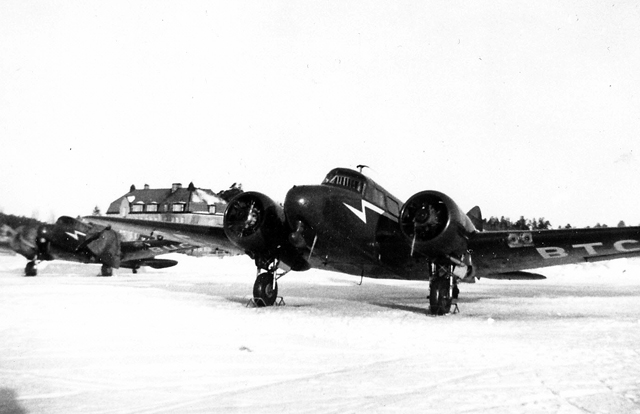
Two Airspeed at the ramp at Bromma Airport, outside during winter, The aircraft is SE-BUC to left and SE-BTC at right.
Photo: Transair TSA.
Transair operated 3 Airspeed; SE-BUC AS65 Oxford, SE-BTB AS 65 Consul and SE-BTC AS 10 Oxford between 1952-1959. SE-BTC was the first of the 3 to operate in Transair TSA livery,
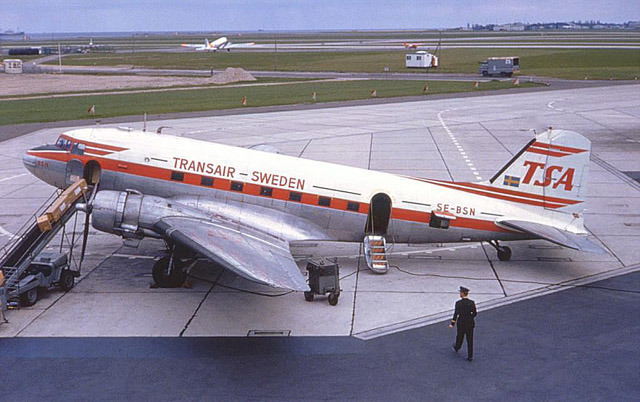
Douglas DC-3, SE-BSN c/n 11 638 at Malmö/Bulltofta Sweden, 1962.
Photo Mel Lawrence.
In the beginning the airline flew evening paper on contract basis to Jönköping for Aftonbladet, one of Swedens largest evening paper. During 1953 Transair bought its first Douglas DC-3, SE-BWD to increase the cargo-tonage and to start passenger service.
The tour-operator Knut-Oskar Gustavsson from Örebro was the first launch-customer to sign a contract of twenty flights to
The aim now was to be in inclousive tour charter business carrying tourists from Scandinavia to centres in Europe and around the Mediteranen aera; Palma de Mallorca and to Rimini, Italy.
In 1954 Palma de Mallorca was included in the programme. A round trip consisting of Stockholm - Palma - Stockholm took 24 hours with the DC-3 inclusive a technical stopover in Hannover.
To increase the number of passengers, Transair decided to purchase a larger aircraft. Their choise was Curtiss CW-20. The first aircraft, SE-CFA was delivered by capt.Carl G von Rosen to their homebase at Bromma airport on the 7th of April 1957.

Curtiss Super 46C Commando CW-20T)SE-CHF cn 33294.
Photo: Lars Söderstöm.
A new office building was built at Bromma Airport but at the same time plans were made to build a new hangar, including service buildings and office premises at Bulltofta airport, Malmö to where they intended to move their business.
1958 Transair TSA Sweden started to fly longhaul flights to Rhodos.
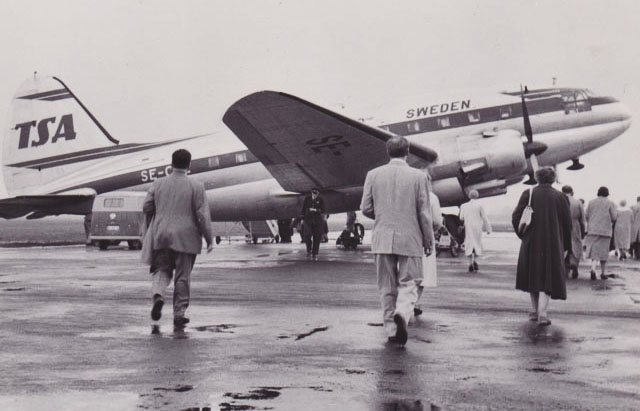
Transair C-46 Super Curtiss SE-CFT longhaul flight via Budapest and Athens to Rhodes1958.

The timetable
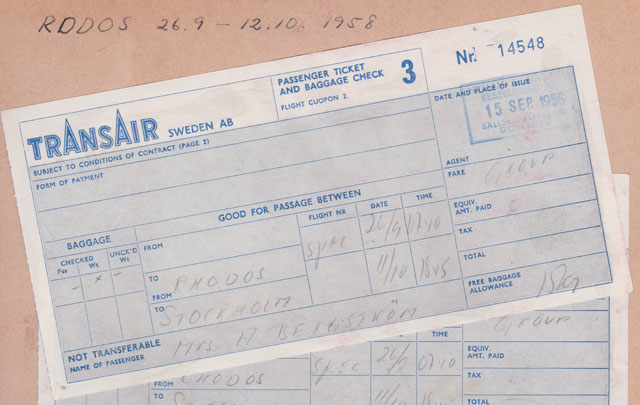
This is an airticket from 1958, the oldest of them that I can present.
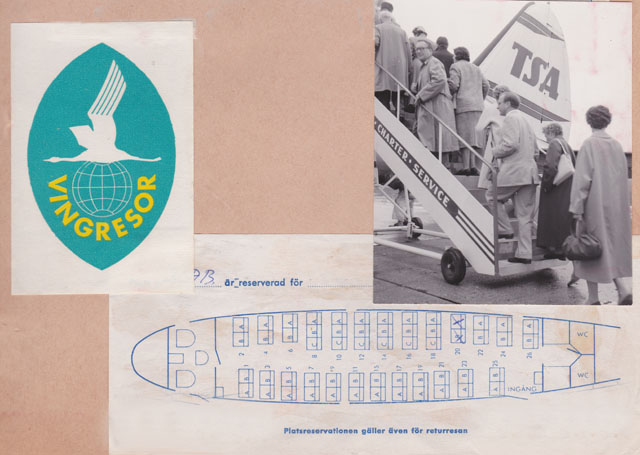
At last the passengers were boarding the aircraft bound for Budapest.
Thank you Lage Bergstroem for the interesting documentation from his Mothers flight to Rhodes.
In October 1958 the company was reorganized and moved its homebase to Bulltofta Airport in the outskirt of Malmö in the southern Sweden. For a period of two years, SAS had 50 percent of the shares in Transair. In June 1964 the company was sold back to Nyman & Schultz, one of the largest tour-operators in Sweden.
In the end of 1959, Transair purchased three DC-6´s from Scandinavian Airlines System (SAS. An extensive reorganisation was carried out in 1960 under the leadership of the director Gösta Ellhammar who had been appointed director of Transair the year before
Las Palmas, Canary Islands were the companys new target. Further DC-6´s and DC-6B`s were included in the airline`s fleet.

With the new Douglas DC-6B in the fleet, Transair was able to shorten flight times and fly further. With the fourth engined DC-6B it was now possible to fly to Las Palmas, however, with a technical refueling stopover.
1963

Here seen the Transair TSA DC6-B-477B Cloudmaster, SE-BDO from the airside at Bromma/Stockholm Int Airport, Sweden.
Photo: Tony Edlind.
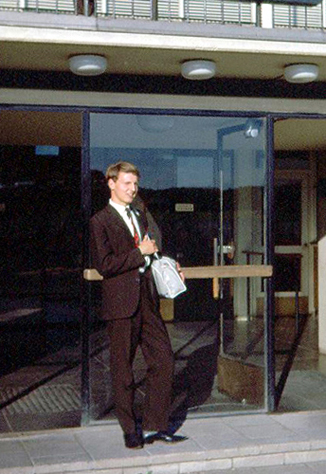
Ready to board the Transair Douglas DC-6, SE-BDO
flight TB131/469 to Rimini, Italy. (Author).
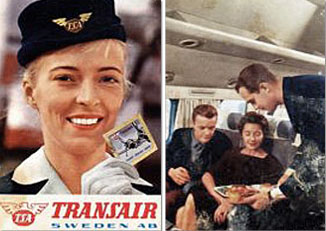
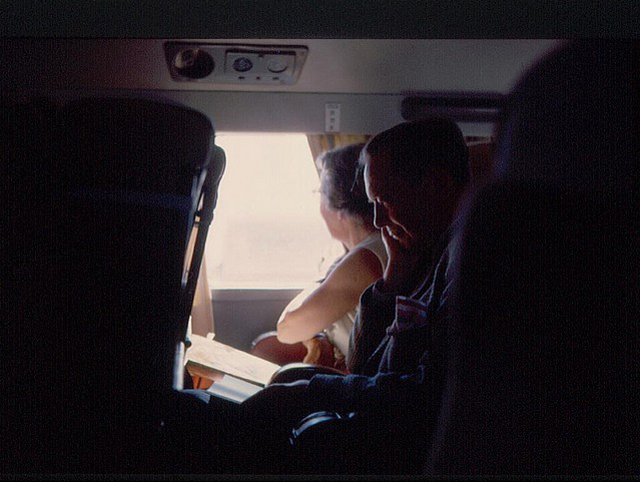
Onboard the Douglas DC-6 from Bromma/Stockholm to Malmö/Bulltofta.
Photo Tony Edlind.
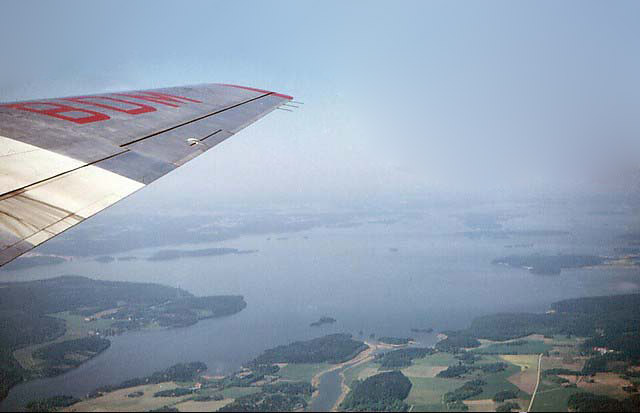
Lake Mälaren west of Stockholm
Photo: Tony Edlind.
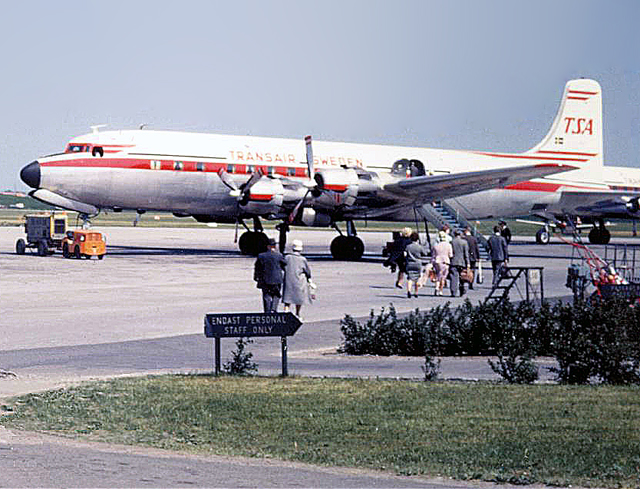
Boarding the Transair TSA, flight TB473 to Rimini, Italy on the Douglas DC-6B, SE-BDZ "Norr-
köping" cn 45079 at Malmö/Bultofta, 1963.
Photo Tony. Edlind

Transair TSA DC6-B-477B Cloudmaster, SE-BDO on final to Bulltofta/Malmoe airport; Sweden.
Photo: Tony Edlind.
1967
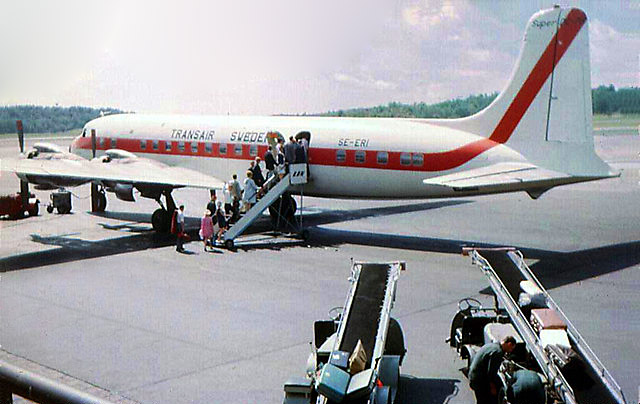
Douglas DC-7B, SE-ERI at Stockholm Bromma, 1967 flight TB578 to Rhodes, Greece.
Photo: Tony Edlind.
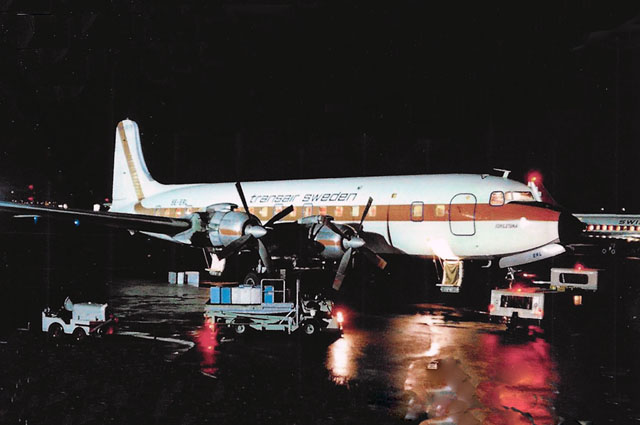
Douglas DC-7B, SE-ERD c/n 45089 at Ellinicon Airport, Athen 1967.
Photo: Tony Edlind.
In 1965 the airline started to operate the Douglas DC-7B . Nine secondhand aircraft were purchased from Eastern Airlines and two from South Africa. The aim was to update the fleet with aircraft with a better range and speed and the number of passenger capacity onboard. But this decision taken by Ellhammar himself was the most fatal decision for Transair, to change the reliable DC-6´s to the DC-7´s which had continually troubling turbo-compound engines.
But the propeller era was almost over. The DC-7s were now less profitable than other jet-aircrafts on the market, such as Caravelle´s, Boeing 707´s and DC-8´s. The passengers demanded better comfort and speed. A direct flight by DC-7 from Stockholm to Las Palmas was estimated to 11 hours 30 minutes and by jet aircraft to approximatly 6 hours. Then the Transair decided to purchase 2 Boeing 727-134 in an 131 pax all-economy configuration to compete on the market charteroperation markets.
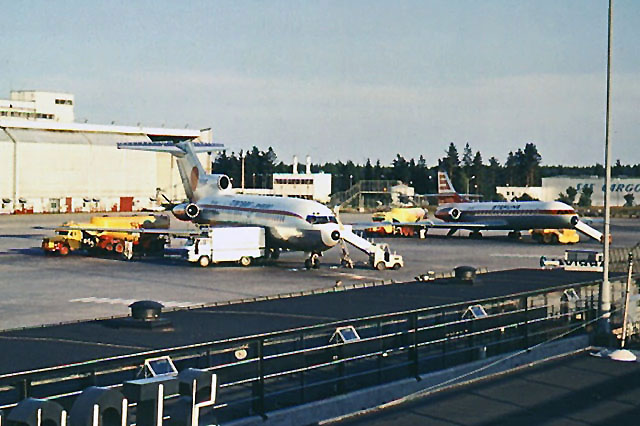
Boeing 727-134, SE-DDD at Arlanda/Stockholm airport, Sweden 1967
Photo: Tony Edlind.

Boeing 727-134, flight TB563 to Barcelona airport, Sweden 1967
Photo: Tony Edlind.
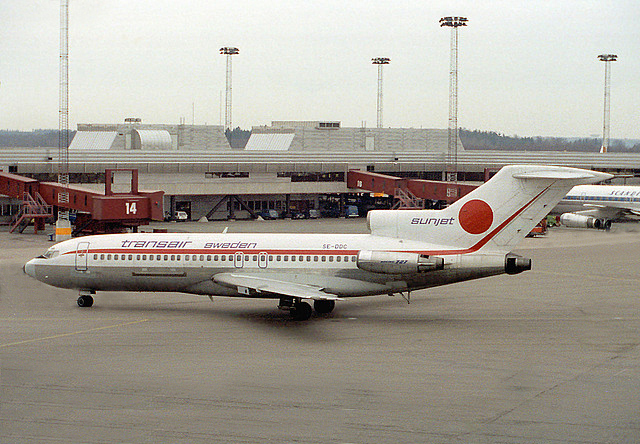
Boeing 727-134, SE-DDD at Arlanda/Stockholm airport, Sweden
Photo: Derham Chaloner
The jet-age started in 1967 when Transair took delivery of one Boeing 727-100 aircraft. A total amount of three aircraft where ordered. The inauguration fligth to Las Palmas in the "Midnight Sun" SE-DDA took-off from Bromma airport on the 23rd of November 1967.
During 1967 the ownership of the company was changed. The company was owned by Svenska Handelsbanken and its holding company Trident. The aircraft were owned by Eriksbergs Mekaniska Verkstad AB in Göteborg. Since 1972 Transairs home-base was Sturup Airport some 35 kms east of Malmö.
The first joint-venture with Scanair (SAS group) started 1968.
The three Boeing 727 aircraft were rented to SAS for fourteen years. During the years 1967-1979 the airline operated four Boeing 727-100, two aircraft were equiped with cargo-doors.

Boeing 727-30C, SE-DDD in front of hangar at Sturup airport
Photo: Transair TSA.
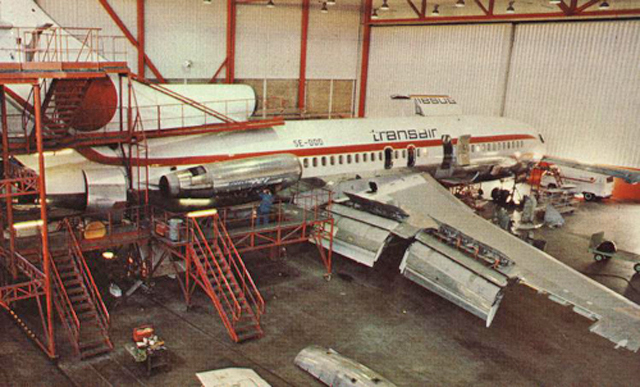
Boeing 727-30C, SE-DDD in hangar
Photo: Transair TSA.
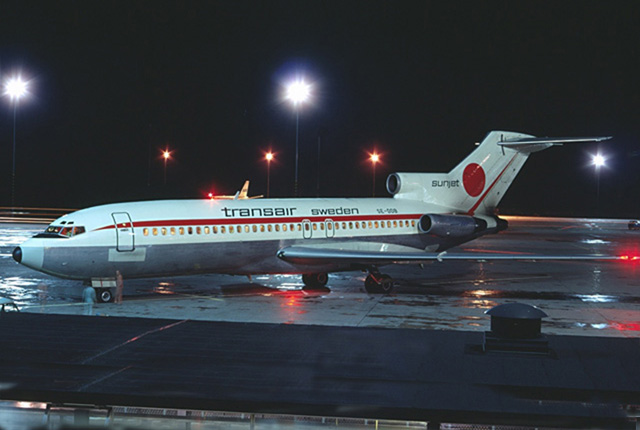 Photo: Kjell Nilsson.
Photo: Kjell Nilsson.
During 1975, SAS acquired Transair and the company continued to operate for Scanair. Transair bought and operated the fourth Boeing 727 in 1979 but the engines were already "out of date" and the increasing cost in fuel made the aircraft less profitable and Transair struggled to survive the charter operations.
Epilogue
Transair flew on 6th of September 1981 the last charter-flight with passengers from Rhodos to Malmoe. And on 8th of September the airline has come to the end of an epoch, Transair Sweden made its last flight, a subcharter cargoflight for Scandinavian Airlines from Copenhagen to Narssorssuaq, Greenland.
The fleet of 4 aircrafts were sold. 2 aircrafts to Philippine Airlines, 1 aircraft to Emery Air Leaseing and the last aircraft to Nomads Inc, USA. The amount was 70 million SEK, nearly the cost of 3 aircraft.
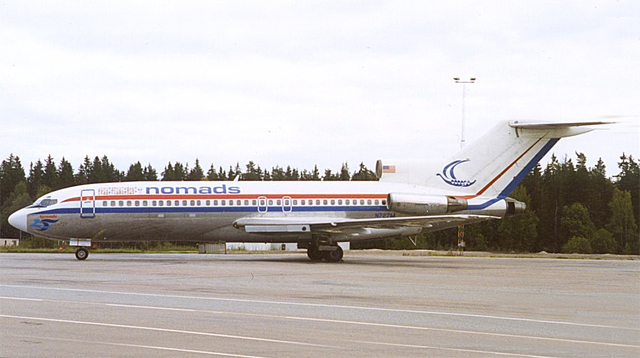
The last Transair TSA Boeing 737-131, SE-DDD leaving Stockholm-Arlanda as N727M to Nomads Travel Club, USA 1981.
Photo: Rainer Nyberg.

